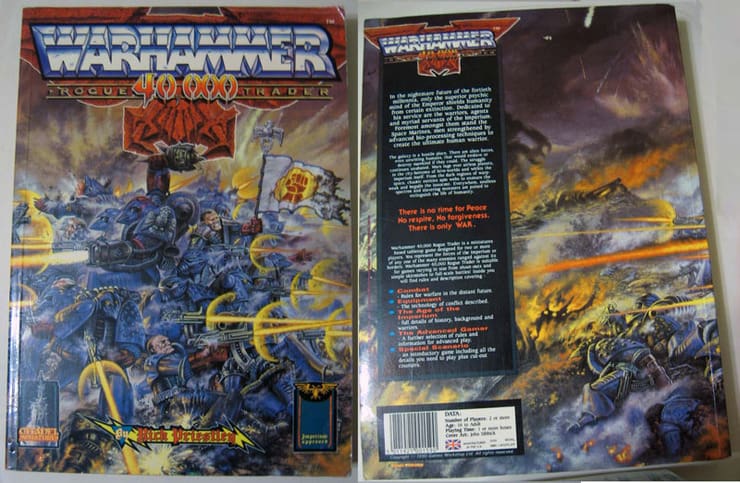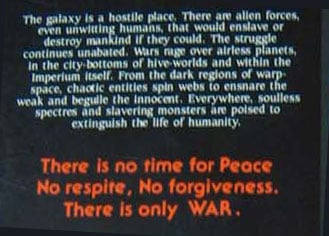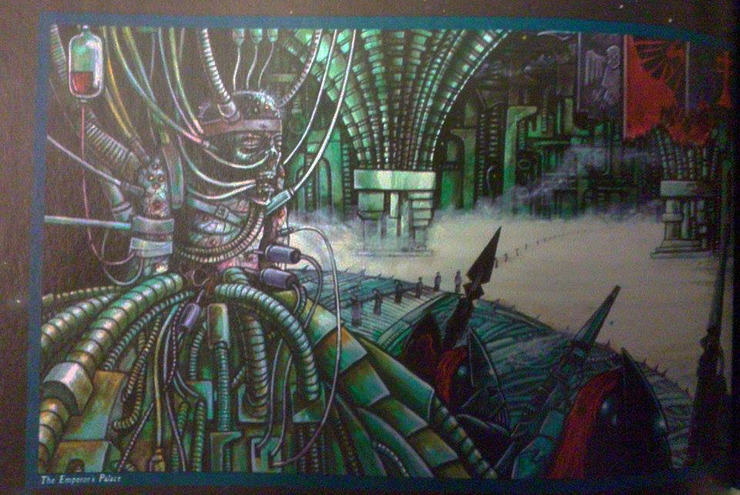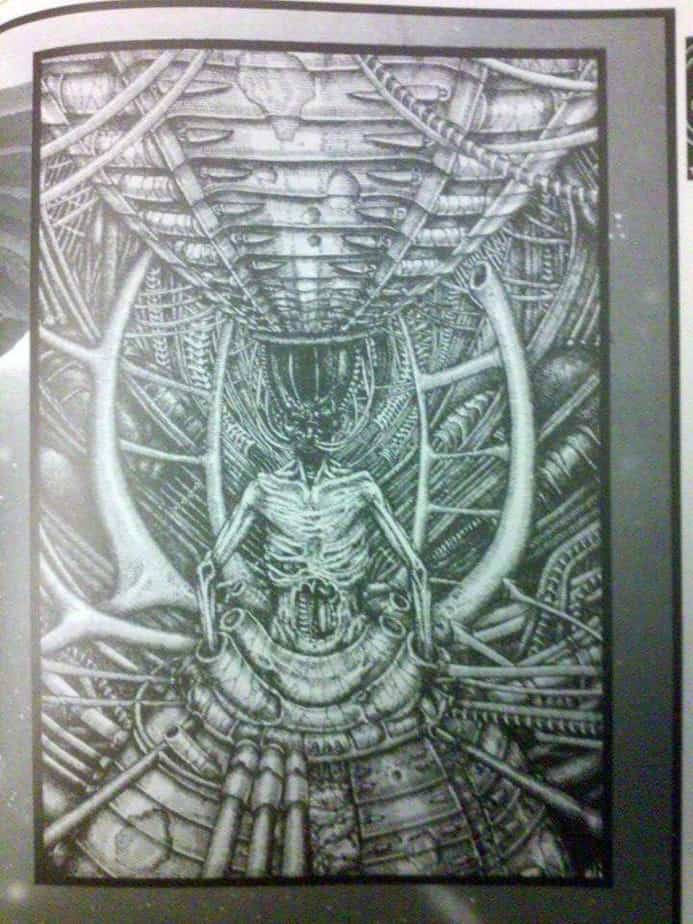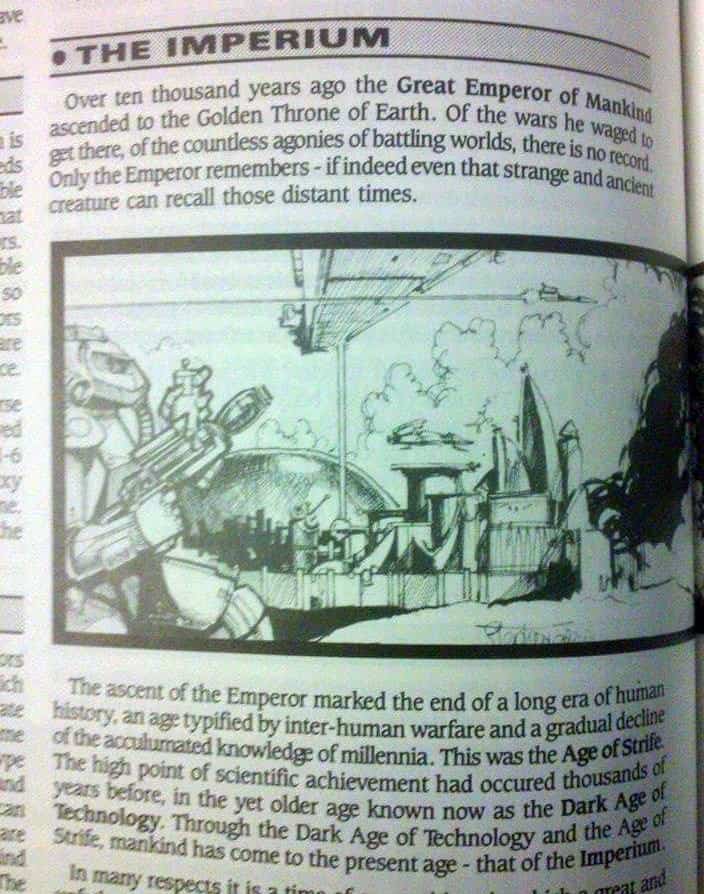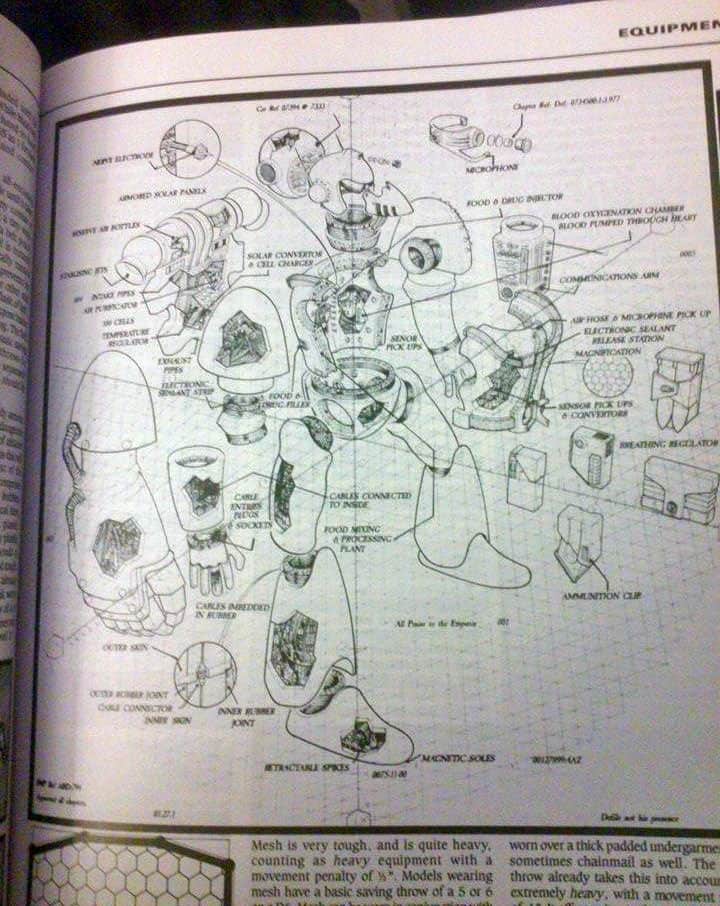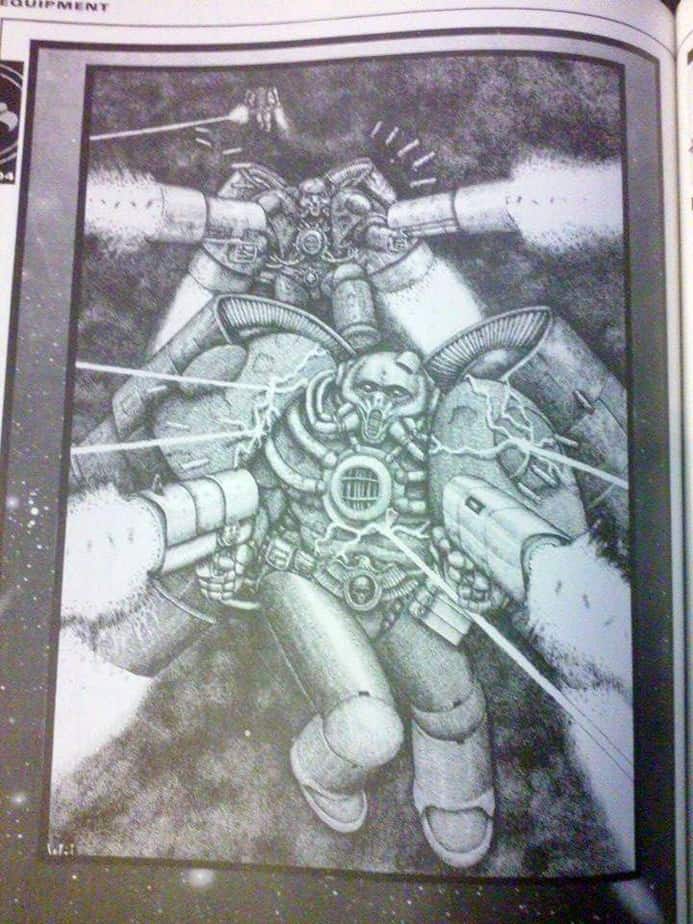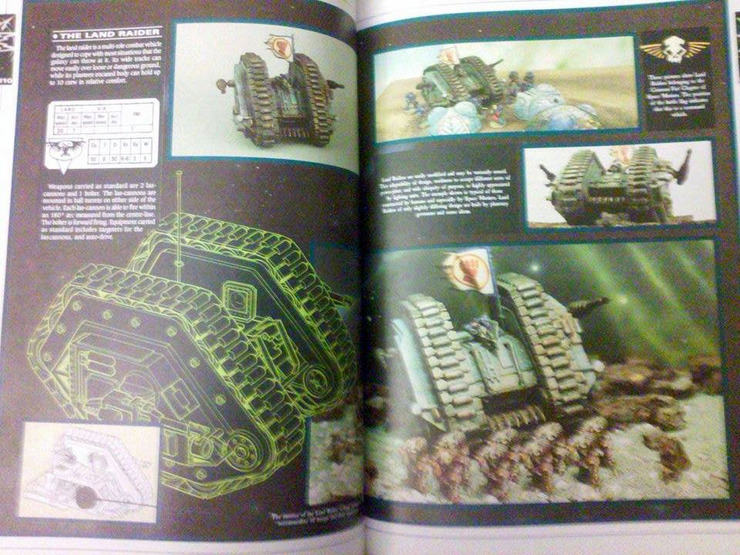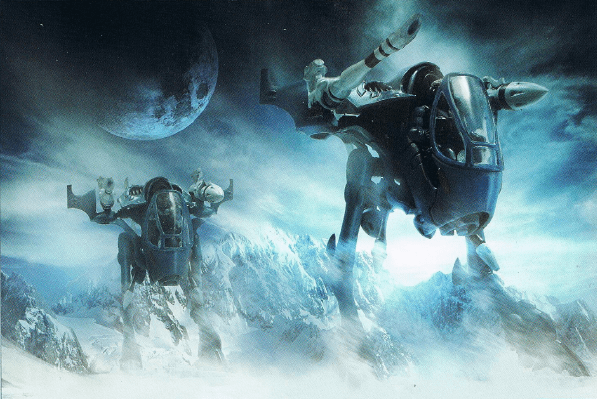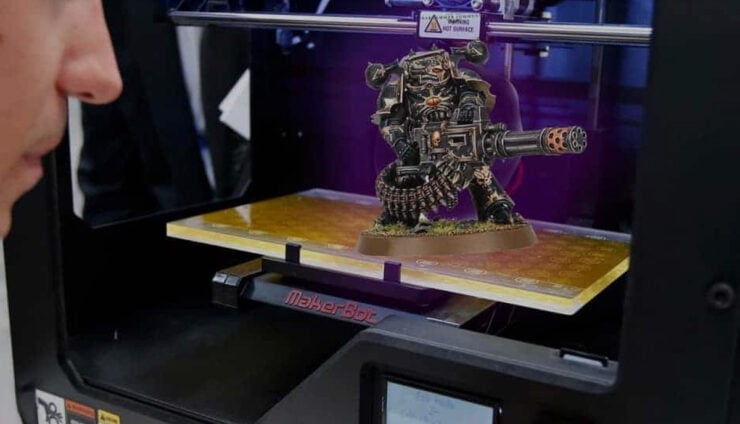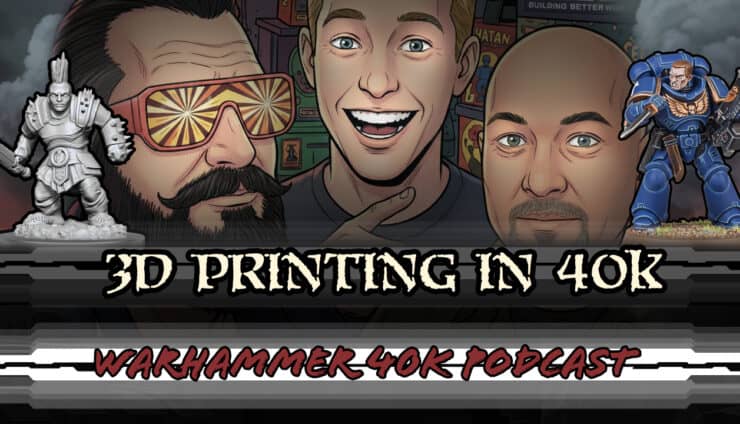Hello again from Brass Scorpion (aka Bob), I’m back from The Warp where I’ve been fraternizing with the new GW Bloodthirster model (i.e., painting it).
Though I usually write painting and conversion articles I thought I’d do something a little bit different this time. It’s common knowledge that Games Workshop’s Warhammer 40,000 Rogue Trader (aka 40K) was first published in 1987 with Rick Priestley’s name on the cover, but did you know that some of the most famous and popular parts of modern 40K were sown as mere tiny seeds in that original version? Let’s have a little trip down the memory lane that is the grim dark highway to 40K’s humble beginnings.
First, as you can see from the photo of the back and front cover of the book above, the Crimson Fists were the featured Space Marine chapter. The Ultramarines were still a few years away from becoming the “poster boys” of 40K and Space Marines in general. Interestingly, Blood Angels were featured on the cover of 2nd Edition 40K, the first boxed version released in 1993. Ultramarines didn’t get a starter set or main rule book cover till the 4th Edition 40K Battle for Macragge starter set, so take that Ultramarines haters (i.e., people who complain about Ultramarines getting too much attention). Check out the gauntlet mounted weapon, maybe a grenade launcher, on one of the Space Marines on the front cover. There was actually a model for that too, I own one of those original bits of lead goodness.
However, the back cover of the original 1st Edition rule book features the famous “There is only WAR” phrase still used by Games Workshop to this day 28 years later. When something works for you, then you stick with it!
Now what about The Emperor of Mankind? How much mention did he get in the original version of the tale? Well, The Emperor was mentioned and he was in just as bad a shape in the 40K lore then as he is today. Check out this full color artwork from inside the book titled, “The Emperor’s Palace”.
The Emperor is described in detail on page 135 of the book and little has changed in that description over the decades. He was an immortal psychic freak of nature from the start and the current descriptions of how he used his abilities to protect humanity as an emerging psychic race from the perils of The Warp were penned in this original 40K tome. His regime was described as harsh from the beginning too. The Emperor got an entire page of black-and-white artwork as well. He does not look healthy there either. One can also tell from this piece of art how heavily influenced the GW design studio was even then by H.R. Giger’s work for Alien.
Now what about the back story, the seminal lore of 40K? How did the Imperium begin? What of the great wars that built the Imperium and the Horus Heresy that nearly ended it? Well, at the time GW’s new little role play skirmish game of science fantasy left most of that to the imagination of the players. The framework we know today was set, but little in the way of detail was scripted. Years later GW would realize there’s a lot of merchandise and money to be made filling in the details through countless novels and lore sections of rule books, but in 1987 they left most of it to your imagination. The Horus Heresy gets its first brief mention if I recall in the first 40K supplement, Chapter Approved, not in the first core rule book. Here are two brief paragraphs from the Rogue Trader book describing the Imperium and its creation.
As you can already see, some of the most important elements of 40K were set from the beginning. The Legiones Astartes, more commonly known as Space Marines, are described starting on page 153. While the description of how a human becomes a Space Marine is less elaborate than it would become years later the concepts of bio-enhancement to make them more than human were already there. GW would expound on and add many elements to it over the years. Of course, Space Marine models would be no fun to assemble and paint as models without their iconic powered armor (see Robert Heinlein’s 1959 novel, Starship Troopers for that original concept as well as the jump pack and hand flamer) and the Rogue Trader book does not disappoint in this area. There’s a full cutaway artwork for it! Power fists were there at the start, which makes me happy. Who doesn’t like gigantic powered armored gauntlets?
There’s even some artwork of Space Marines with jump packs, the design of which in this early artwork has made a big comeback in the model design the past few years. The helmets are somewhat grotesque in this artwork and perhaps more in line with Chaos Space Marines today. Check out the size of the dual pistols wielded by these guys!
The Land Raider tank makes its first appearance here as well in a nice 2-page spread.
Some ideas that were dropped years ago to keep the model range more manageable have made a comeback in recent years either through Forge World or even by insidiously making their way back into the mainstream GW product line. Battle robots or automatons were there at the start. The artwork below shows one destroying an Ork. The concept of arcane “machine rituals” rather than just engineering and maintenance through science are mentioned as well. 40K was a science fantasy game from the start, allowing it to be much more free form and fantastical in nature than a game based on hard science or science fiction. Of course, GW’s earlier game creation, Warhammer Fantasy Battle, played a big part in 40K’s development and many of its elements, including the aliens that inhabit it, come to 40K via Warhammer Fantasy. Of course, GW infamously dropped one of the most blatantly Fantasy Battle inspired model ranges from 40K after 1st Edition, the Squats. If you want to learn more about “Homo Sapiens Rotundus”, you’ll find them on page 175.
Well, I could go on like this forever, but then I’d be posting the whole book and that’s simply neither legal nor practical. There is just so much cool stuff in this first book you wouldn’t believe it. So may I suggest that if you don’t own a copy of this fantastic tome that you find yourself one if possible. I often see them on eBay and many times they are not terribly expensive. This book cost $35 US when I bought it back around 1989, so if you see one for $50 or less now that’s a great price, grab it! It really is entertaining beyond measure looking through this book and I had a blast revisiting it myself for the first time in a long while for the sake of this article. Then as now, “there is no respite”, from fun!
This article was way too enjoyable to write. I had forgotten just how much of today’s 40K is right there in that original book and I definitely want to re-read a good chunk of my now fragile and aged tome again after many years away from it. And though I’ve parted with many classic Warhammer rule books over the past few years to make room for new ones, my copy of 40K Rogue Trader is definitely not for sale!
